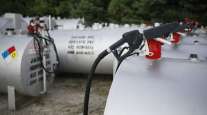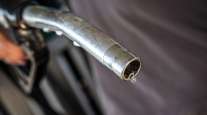Diesel Drops 5.2¢ to $2.542
This story appears in the July 20 print edition of Transport Topics.
The average cost of retail diesel in the United States dropped 5.2 cents a gallon last week to $2.542, the third consecutive decline and a level nearly 50% below the record highs of a year ago.
The current price of commercial trucking’s main fuel is $2.222 a gallon below the record $4.764 per gallon set on July 14, 2008, the Department of Energy reported after its latest survey of filling stations.
DOE analysts said the decline at the pump was largely a reflection of the weak economy and falling crude oil prices. The survey was conducted July 13.
“The primary reason [fuel is] going down is because the price of crude oil is falling,” said Tancred Lidderdale, a senior economist with DOE’s Energy Information Administration. He added, “One of the factors bringing the price of crude oil down is the expectation that the gasoline market has passed its peak.”
DOE reported that the gasoline average price declined by 8.4 cents a gallon last week to $2.528, falling back below the diesel average for first time since May 4. The gasoline average was $4.113 one year ago, or $1.585 a gallon more than last week. Last week was the lowest price for gasoline since June 8.
American Trucking Associations estimates that the U.S. trucking industry burns 752 million gallons of diesel weekly and 285 million gallons of gasoline. At those rates, truckers paid about $39 million less for diesel and $24 million less for gasoline than the prior week, July 6.
Crude oil was trading at $62.02 a barrel on July 16 on the New York Mercantile Exchange, well below its June 29 closing price of $71.49 a barrel.
But cheaper oil isn’t compensating for the slow freight market, which is making it more difficult for some truckers to recoup their fuel expenses, said Karen Pelle, founder and chief executive officer of Megatrux Inc., Rancho Cucamonga, Calif.
“We finally trained people that there is a fuel surcharge — there is a hike in the cost of fuel, and it’s got to be passed on,” Pelle said. “Now, with all the downturn in the economy, they’re not as sympathetic. You’re lucky to get a fuel surcharge off the East Coast.”
“It’s frustrating that the American business public isn’t conscious of the cost of fuel,” Pelle said.
Doug Houff, president of Houff Transfer Inc., Weyers Cave, Va., agreed.
“I worry more these days about the revenue per mile — the rates — than fuel,” he said. “The rates are terrible.”
He said his company, which has 150 power units and 600 trailers, also is having more difficulty collecting fuel surcharges.
“We had a customer just the other day say she wasn’t going to pay any more fuel surcharges,” Houff said.
He buys fuel from several different suppliers located near the company’s terminal network. “We have about five different suppliers, and we check the price of fuel every day and go with the cheapest one,” he said.
EIA’s Lidderdale cautioned lower pump prices could be short-lived. He suggested the current market is similar to January and February, when crude declined but then rebounded each time.
“The market is taking any kind of news, good or bad, really strongly to heart,” he said. “Prices in any forecast are highly uncertain in this market and this economy.”
Lidderdale said a rule of thumb is that for every dollar decline in the price of a barrel of crude oil, there is an eventual corresponding drop of 2.4 cents a gallon of refinery product at the pump.
“So, the expectation is that the price of diesel probably is going to continue to weaken a little bit as the lower cost of crude oil gets through to the pump,” he said.
Other factors in the price decrease include larger distillate stocks, the highest in 20 years, likely related to a drop in demand for diesel, he said.
“Diesel demand has dropped from 3.95 million barrels a day last year to 3.67 million barrels a day this year — a 7% decline,” Lidderdale said.
EIA economist Laurie Falter added, “What we’re expecting now is that diesel prices likely are going to remain at this level or soften a little bit more in coming weeks. We don’t expect at this point to see any increases in diesel prices from now through the end of August.”
Nor does Falter expect diesel prices to reach the all-time high levels they did last summer.
That could take years, she said.
“If we see a rebirth of demand, then sure, we could see prices go up again to those sorts of levels, but I wouldn’t expect that anytime in the next year or longer,” Falter said.




